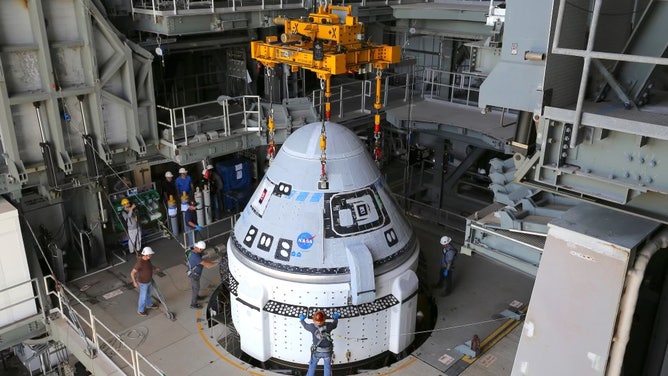How Boeing’s Starliner spacecraft, crew will avoid potentially deadly ‘black zones’ during trip to ISS
Boeing and ULA are preparing to launch NASA astronauts Suni Williams and Butch Wilmore on the Starliner spacecraft. Wilmore said Starliner is able to avoid “black zones" the space shuttle program had where a potential failure could be deadly.
Boeing's Starliner capsule lands safely back on Earth
Boeing’s Starliner capsule lands safely back on Earth after visiting the International Space Station
KENNEDY SPACE CENTER, Fla. – Ahead of Boeing’s Starliner spacecraft's first crewed launch, two veteran NASA astronauts reflected on the differences between their previous rides to space, including the new ability to avoid areas known as "black zones" where a spacecraft crew would likely not survive if a failure occurred.
The crew test flight (CFT) with NASA astronauts Suni Williams and Butch Wilmore marks the final milestone for Boeing's spacecraft designed to fly humans to and from the space station.
NASA and Boeing plan to launch the Starliner on a United Launch Alliance Atlas V from Launch Complex 41 at Cape Canaveral Space Force Station in Florida at 12:25 p.m. ET on June 1. This will be the second launch attempt after a May 6 countdown ended in a launch scrub due to a faulty oxygen valve on the rocket.

The CFT Starliner being integrated to ULA's Atlas V rocket in Cape Canaveral, Florida on April 16, 2024.
(Boeing)
NO 'JITTERS' FOR NASA ASTRONAUTS PREPARING TO LAUNCH ON BOEING STARLINER SPACECRAFT
Both astronauts previously launched on NASA's space shuttle and Russia's Soyuz spacecraft. The astronauts spoke to reporters before the launch, expressing their confidence in the spacecraft design and saying it has more differences than similarities to their previous spaceflights.
Unlike the space shuttle, the Starliner spacecraft offers additional safety with pad and launch aborts throughout its trajectory to space. These aborts would send the spacecraft away for a landing via parachute and the airbag system on the Starliner.
Wilmore described the shuttle program's "black zones," saying Starliner does not have these.
"There were many what we call the term ‘black zones,’ where if you had specific failures in certain parts of the trajectory as you're getting into orbit, you could not survive. You would not survive if you had certain failures," Wilmore said. "This spacecraft does not have those."
Wilmore said Starliner did have "black zones" on re-entry, but after changes, the astronauts now can use a "backup mode" and manually guide the spacecraft down to landing.

From left to right, NASA astronauts Suni Williams and Butch Wilmore pose in front of Boeing’s Starliner spacecraft in the early morning of Tuesday, April 16, 2024, outside the company’s Commercial Crew and Cargo Processing Facility at the agency’s Kennedy Space Center in Florida. Photo credit: NASA/Kim Shiflett
(NASA)
He said this allows the astronauts to control the spacecraft "to a pinpoint landing back here on Earth."
"You can go into a backup mode halfway through an entry and still hit the bullseye when you don't even have your computers. That's pretty remarkable. And this is the only spacecraft that can do that," Wilmore said.
BOEING STARLINER SPACECRAFT ARRIVES AT FLORIDA LAUNCH FACILITY AHEAD OF ASTRONAUT TEST FLIGHT
Starliner is designed to land on land for re-entry, but during an emergency launch abort, the spacecraft would splash down in the Atlantic Ocean.
"We can abort from the pad all the way up through orbit. So that capability is great, and we're on the tip-top end. So we'll be OK. I'm not going to say that ride is going to be super calm, but we'll be OK," Williams said.
Boeing, ULA and NASA plan to launch Williams and Wilmore to the International Space Station on Monday night for a weeklong test flight. A successful CFT will culminate in a soft landing of the Starliner spacecraft in the Southwest desert.
